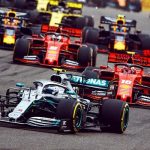1948 and all that The Land Rover was far from the only stand-out in a watershed year. Giles Chapman picks his highlights from around the globe.
ALSO IN 1948
In 1948, the British Motor Show finally returned to Earl’s Court in West London after a gap of ten glum years. Here was an automotive cavalcade the like of which would rarely be witnessed again, and a bumper 562,954 visitors queued in the chilly October air to get in.
The headline acts, of course, were the impossibly rapid and beautiful Jaguar XK120 and the highly significant, almost-all-new Morris Minor. But virtually every manufacturer’s stand space framed brand new cars. In the dull-but-important category, a veritable galaxy of newcomers for everyday motoring included the Austin A70 Hampshire, Hillman Minx, Morris Oxford, Singer SM1500 and Vauxhall Velox/Wyvern. Many also had their first glimpse of the Jowett Javelin and Standard Vanguard.

Jaguar’s MkV and the Lagonda 2.6 represented the latest in British luxury, while the Daimler DB18 Sports Special Sports and Lea-Francis, Alvis TB14 and Triumph 2000 roadsters catered to fresh-air fantasies.
The US-influenced Austin A90 Atlantic convertible was like nothing else around but, as with much of the other tempting new metal, it was almost exclusively for export. The car industry was focused on selling abroad to suck foreign currency into the beleaguered British economy, although in one crucial foreign market, Australia, the locally conceived Holden would provide stiff opposition. You could admire the gleaming Earl’s Court line-up, but getting your chequebook out was largely futile…

Cars 1948
Morris Minor
If he’d been allowed to by the abacus-swipers of Morris Motors, Alec Issigonis would have installed an eager flat-four motor in the Minor. Denied that, he still ensured this was the first British economy car with proper driving appeal. The combination of rack-and-pinion steering, a snappy floor- mounted gearchange, supple torsion-bar front suspension and a wide track made it precise and stable. The lovable character came from the car’s curvy proportions and roomy cabin. The Minor was one of five inter-related Morrises and Wolseleys arriving in ’1948, the other significant one being the rapid Wolseley 6/80 that was embraced by Britain’s crime-fighters.
Citroën 2CV
This was an ‘umbrella on wheels’, according to Maurice Broglie, its chief engineer, and much as it astonished and intrigued the throng at the 1948 Paris motor show, it wasn’t just the 9bhp 375cc flat-twin engine that slowed it down. It was the Nazis, too. The 2CV had been scheduled for unveiling in 1941; gritted-teeth Citroën management did an excellent job of hiding prototypes in a rural hayloft. Then, they found the austere post-war environment was just ideal for a super- basic car costing a third of the Traction Avant’s price. The flimsy bodywork, tubular seat frames and all-round minimalism did the trick, while front-wheel drive and long- travel interconnected suspension made it intrepid and capable in the most isolated corners of the Massif Central. And yet it still became the first Citroën ever with a four-speed gearbox.
Panhard Dynavia
Never heard of it? Don’t beat yourself up. If you didn’t happen to visit the Paris and London motor shows in 1948 to gawp at it, then you’d have been lucky to see the only roadgoer, a replica fora Grenoble dealer that had a short and glorious life before being written off. Why is it here? Well, obscure or not, the Dynavia is the grandfather of all European concept cars – an aerodynamic teardrop intended to soften-up buyers for the car of the future. A one-fifth scale model achieved an incredible drag factor of 0.17 in 1945; the full-size car was almost as impressive at 0.26, and it paved the way for the radical Dyna Z of 1954.
Land Rover
There was indeed a Land Rover at Earl’s Court in 1948, carrying a stylish, seven- seater, coachbuilt station wagon body – the standard version was a purely commercial vehicle, so it wouldn’t have been allowed to rub shoulders with Rover’s cars at the event. Meanwhile, all over the country, the farming community was wide-eyed with excitement at Britain’s revolutionary hybrid pick-up/ tractor with its selectable four-wheel drive, as it tore across muddy fields and bounced up and down hillsides. It was, at the time, an ingenious sideline to Rover’s conventional cars, and yet just two years later it was out- selling them.
Bristol 401
Aeroplane manufacturers don’t cave in to penny-pinching because it can be, literally, a matter of life and death. This mindset prevailed with Bristol’s ambitious stablemate for the BMW-esque 400. As a result, the
£3112 price of the four-seater 401, swelled by purchase tax, was three times that for the just-launched Jaguar MkV of ’48. Even then it barely covered the cost of making it. Still, it was a beautifully balanced machine, the wind tunnel-tested, handmade body using Italian superleggera-style construction. It was sumptuous inside and could break 100mph
I needed twice the engine capacity to match its performance.
Jaguar XK120
Well, 120mph turned out to be rather an under-estimate for the star of 1948’s new car crop – the heavenly two-seater hit 132mph at Jabbeke in 1949, upped to an astounding 172mph in 1953. By then, the XK120 was one of the world’s most desirable sports cars. It was a long way from William Lyons’ original plan – a limited-run two-seater to showcase the twin-cam XK engine that, really, was intended for his MkVII saloon. The sports car took on a life of its own the moment the wraps were off, with its 160bhp power, crushing performance and that timelessly sleek and glamorous profile. A 2-litre four-cylinder option never went ahead, and even the aluminium bodywork had to be changed to steel to meet demand.
Porsche 356
Project No 356 was completed on 8 June 1948 in Austria, and revealed the following month to the public at the Swiss Grand Prix. It was designed by Ferdinand ‘Ferry’ Porsche, and not his father Ferdinand, who was responsible for the Beetle. Although the old man approved of his son’s vision for a simple weekend roadster, this was rather more than a sporty VW. The tubular chassis and alloy body were bespoke affairs just for the mid/rear-engined 356, while only the torsion-bar suspension and very basic hardware from the VW’s flat-four engine were carried over. The definitive 356 arrived in 1951, the year Ferdinand passed away.
Sunbeam-Talbot 90
It wasn’t looking too promising for this four- door when it appeared in mid-’1948. Aside from handsome bodywork and the 64bhp 2-litre Humber Hawk engine converted from side- to overhead-valves, the chassis was entirely separate and it had antique leaf springs front and back. The column ’change clashed with the individual front seats. The transformation to decent compact sports saloon came in 1950 with independent front suspension and a bigger 70bhp 2.2-litre engine, while better brakes arrived on the 77bhp MkIIA in ‘1952. Finns Per Malling and Gunnar Fadum won the 1955 Monte Carlo Rally in one… with a broken fanbelt.
Cadillac 62
These beefy, confident Caddies were the first cars from General Motors to sport all-new bodywork since the end of WW2. And what a highly influential piece of work the design was. Overseen by Harley Earl, this was the first car from Cadillac with tailfins, copied from the Lockheed P-38 plane; it was the start of the marque’s journey into the joyous automotive excesses of the 1950s. Detroit truly was setting the pace, and the fastback coupe model provided plenty of inspiration for the Bentley R-Type Continental. Just a year after launch, the cars received an overhead-valve V8 for a more responsive driving experience.
Hudson Commodore
Plucky Hudson shocked the Detroit big guns with its radical range of ‘Step Down’ cars, where driver and passengers stepped down into their seats rather than clambering up to them. Hudson named its construction method – the floorpan was suspended from the chassis instead of being bolted on top – ‘Monobilt’. The chassis extended around the outside of the rear wheels, which allowed stylists to create a ground-hugging look. The Commodore came with an elderly 4.2-litre straight-eight or a new ‘Super Six’; the latter, in 145bhp form, made the similar Hudson Hornet a champ in NASCAR’s first Daytona Beach race for stock cars, held in ’1948.
A World Reinvented
It wasn’t just daring new cars for 1948. Everything was changing, mostly for the better if you were British Words Giles Chapman
The sands of global geopolitics weren’t so much shifting in 1948 as being whipped into a storm, the effects of which we all still feel today.
The big regroup saw the state of Israel founded in the Middle East, to the ire of Arab populations in the region, and Indian leader Mahatma Gandhi was assassinated during his attempts to stop internecine violence as Pakistan separated from India. Meanwhile, apartheid rule began in South Africa.
On top of that, in July 1948 the Western Allies sprang into action with the Berlin Airlift after the Soviets blockaded the city to try and drive Brits and Americans out of the divided former German capital. Although they backed down in 1949, some 277,000 planeloads of food, fuel and medicine were flown in over 11 months. And as the Cold War unfolded, Czechoslovakia was deftly pulled behind Russia’s Iron Curtain.
If you’d gleaned all this via then hugeselling but now-defunct daily newspapers such as the News Chronicle and Daily Sketch, or the BBC Home Service, you might have concluded the global conflict had barely ended at all. More positive was the launch of the World Health Organisation to combat global diseases, such as the rising menace of polio, while the United Nations adopted its Universal Declaration of Human Rights. In Britain, the Labour Government was making good on its ambitious plan for free healthcare for everyone, and the National Health Service came into being in July.
Sylvia Beckingham, a 13-year-old with a liver condition, became the first patient treated under the new system. The Government also nationalised the country’s regional train companies to form British Railways, and brought the entire electricity generation and grid system into public ownership. National Service increased from 12 to 18 months. This was some years before rock ’n’ roll arrived and so, even though the vinyl 33⅓rpm LP record was invented this year, ‘pop’ music was dominated by crooners such as Frankie Laine and winsome singers such as Anne Shelton and Dorothy Squires.
People spent their money on going to the pictures to enjoy films such as The Red Shoes and The Road To Rio; 1948 saw 1.5-billion UK cinema admissions, the second-highest ever after 1946. There were just 100,000 TV sets in Britain, mostly owned by the super-wealthy, so the BBC’s 68 televised hours of the 1948 Olympic Games held at London’s White City made little impact on the general public. Japanese and German athletes were banned, though the 100 metres saw the Olympics’ first photo finish.
Silverstone, a former airfield, hosted Britain’s first post-war Grand Prix race where the Maseratis of Villoresi and Ascari came first and second respectively, with Bob Gerard’s ERA third, while Alfa Romeo and Ferrari stayed away. A 19-year-old Stirling Moss showed promise after setting fastest practice lap in the British GP 500cc support race. On the roads, though, rationed petrol meant most drivers could only get enough to fuel 90 miles of driving a month.
There were technological innovations aplenty this year but most – transistor radio, Velcro fastenings and the Polaroid camera – would be a while coming to consumers. Not so one of the first instant crazes of the year: the word-game Scrabble.


